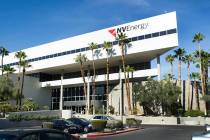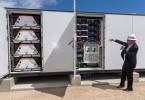Solar, water don’t mix
On a recent road trip to the Midwest, I kept noticing something new on the horizon: windmills. In state after state, wind farms were almost as ubiquitous as cornfields.
The message: Renewable energy is no longer something relegated to the future. It is happening now.
Nevada wants to jump into the renewable energy game in a big way, especially as a gracious host of solar power plants. With its sunny disposition and desolate valleys, Nevada seems well-suited to become a solar industry leader.
But there's a hitch: water.
You see, as a New York Times reporter cleverly put it this week, "an inconvenient truth" about the most economical form of solar energy generation -- the solar thermal plant -- is that it requires a lot of water. The Times explains:
"In such plants, mirrors heat a liquid to create steam that drives an electricity-generating turbine. As in a fossil fuel power plant, that steam must be condensed back to water and cooled for reuse." Under this "wet cooling" method, "hot water flows through a cooling tower where the excess heat evaporates along with some of the water, which must be replenished constantly."
In short, solar thermal plants demand a lot of water -- water that Nevada's dry desert valleys do not have in abundance.
This issue is boiling right now in the Amargosa Valley, about 80 miles north of Las Vegas. A German company called Solar Millennium wants to build two large solar thermal plants there.
The small farming community is divided. On the one hand, the plants would create hundreds of jobs in rural Nevada, which is dying for good jobs. On the other hand, Solar Millennium's plan calls for using 1.3 billion gallons of water per year, representing 20 percent of the valley's available groundwater supply.
At a public hearing in August, Amargosa residents expressed concern that the solar plant's heavy water use could limit water for others. The Pahrump Valley Times quoted Brian Brown, Amargosa Conservancy resource specialist: "This particular technology is not appropriate for one of the driest places in the United States."
This water issue is not unique to Nevada, of course. It's popping up throughout the Southwest, especially just over the state line in the desert areas of Southern California.
There are solutions.
The first is for solar developers to adopt a dry cooling method, which uses fans and heat exchangers. This method uses less water but is more expensive and less efficient.
A second alternative is to build photovoltaic plants, which are like the solar systems found on people's houses. Again, photovoltaic plants are more expensive and less efficient, but they use very little water.
It's vital that we do this correctly from the start. Set a good precedent. Yet, with the exception of those stalwarts in Boulder City, it doesn't seem to be in our nature here to say no to developers. Worried that they might go elsewhere if we get too picky or difficult, Nevada political leaders tend to vote aye first and ask questions later.
This is bad policymaking all the way around, but in the case of solar power plants, we have to consider the big picture and demand that they adopt the most water-efficient technologies available.
I reported recently here that some environmentalists believe they can find common ground with the renewable industry because it doesn't possess the same set of values as the old fossil fuel crowd. Renewable execs, according to this line of thinking, are conservationists at heart, and so they aren't inclined to look only at the bottom line when putting together a project.
One hopes this is the case in Amargosa Valley. Unable to secure water permits, Solar Millennium has already switched to dry cooling at three planned Southern California solar plants. On this issue, at least, what's good for California is even better for Nevada.
Renewable energy could be the next big thing for Nevada, an important and enduring way to diversify our tourism-dependent economy. But we would be foolish to sacrifice one precious resource to produce another.
Consider that the solar project in Amargosa is just one of literally hundreds proposed across the state. If all of these plants intend to guzzle water, it simply isn't going to work -- not for the plants and not for the Nevadans who depend on this water as well. The more water-efficient the plants are, the more of them we could build, and the more we could grow and diversify the Nevada economy.
Which begs a question: If we're going to build scads of solar power facilities in rural areas, shouldn't the available water out there be allocated to the renewable industry instead of being piped to Las Vegas?
Geoff Schumacher (gschumacher@reviewjournal.com) is the Review-Journal's director of community publications. His column appears Friday. Follow him on Twitter at www.twitter.com/geoffschumacher.























